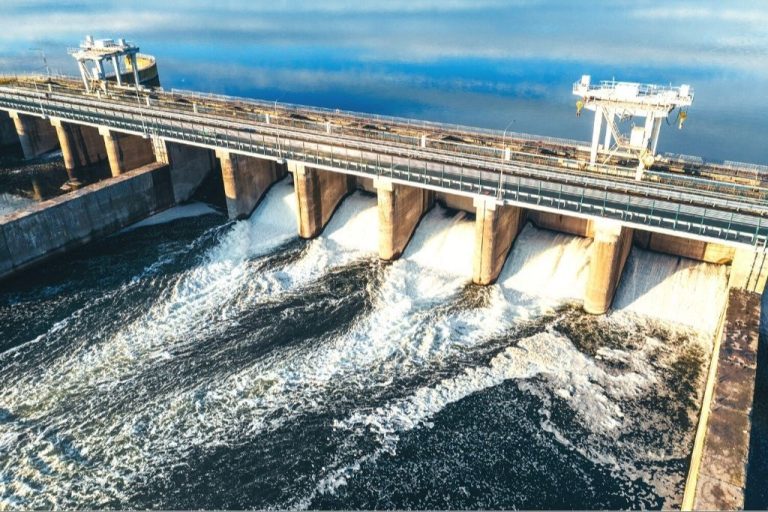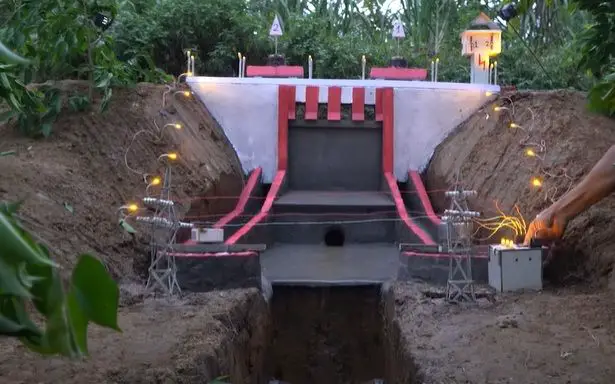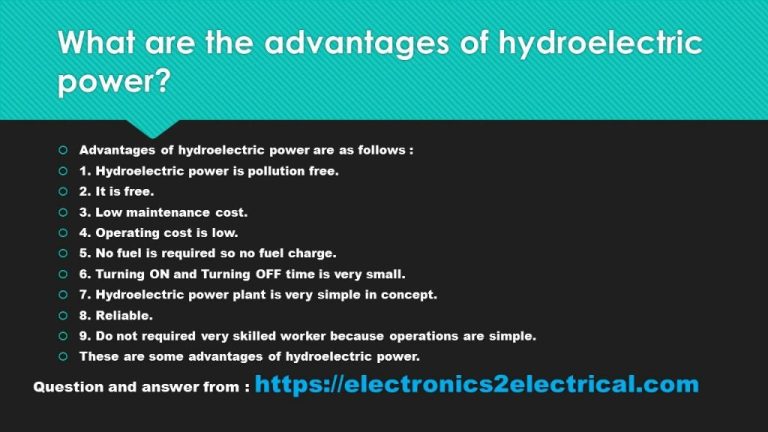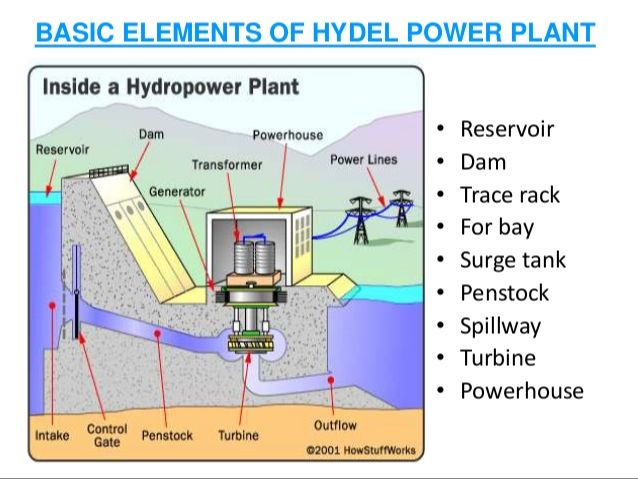Which Energy Forms Go With A Hydropower Dam?
What is Hydropower?
Hydropower, or hydroelectric power, is the process of using the energy of flowing or falling water to generate electricity. It relies on using the gravitational force of water as it moves downhill to spin turbines connected to generators, which in turn produce electricity. Hydropower is considered a renewable energy source since it uses the earth’s water cycle to generate power
The most common type of hydropower plant uses a dam on a river to store water in a reservoir. The water flows through a turbine as it is released from the reservoir. The moving water causes the turbine blades to rotate, which spins a shaft connected to a generator to produce electricity. The amount of electricity generated depends on the volume of water flow and the vertical distance (called head) the water falls. Larger reservoirs with greater water flow and falls can generate more electricity than smaller ones.
Another type of hydropower plant, called run-of-river, channels a portion of a river through a canal to spin turbines. Since it does not utilize a dam or impound water, its electricity generation depends on the natural flow of the river.
Overall, hydropower harnesses the renewable energy of water consistently moving through the earth’s water cycle to provide a reliable and sustainable source of electricity generation (https://www.energy.gov/eere/water/hydropower-basics).
History of Hydropower
Hydropower has been utilized as an energy source for thousands of years. The earliest uses of hydropower date back to ancient Greece, Rome and China, where water wheels were used for grinding grains and powering mills. The power of falling water was harnessed to perform work such as sawing wood or milling flour.
One of the first recorded uses of hydropower was in 200 BCE in the Greek city of Alexandria, where the water wheel and Archimedes’ screw were used to move water uphill. The ancient Romans also used water power extensively for mining operations. In China, water wheels were widely adopted and improved upon to help drive technologies like the blast furnace.
By the 1800s, hydropower began to generate electricity, beginning with mechanical hydropower made possible by the industrial revolution. In 1880, the first hydroelectric power plant was built on the Fox River in Wisconsin, United States. This small plant powered a single building. By the early 20th century, hydropower plants were being constructed around the world at an increasing pace. Major dam projects like the Hoover Dam helped usher in the era of modern hydroelectric power.
Source: https://www.energy.gov/eere/water/history-hydropower
How Hydropower Dams Work
Hydropower dams work by converting the potential energy of elevated water into electricity. A dam is built to store water at a higher elevation. This water behind the dam has potential energy due to its elevated height. When the water is released from the reservoir, it flows downstream through large pipes called penstocks. At the bottom of the penstocks are hydraulic turbines. As the water flows through the turbines, it causes the turbine shafts to rotate. This rotational kinetic energy spins electromagnets inside a generator which then converts the kinetic energy into electrical energy via electromagnetic induction [1].
Types of Hydropower Dams
There are three main types of hydropower dams: storage, diversion, and pumped storage.
Storage dams impound water behind a dam in a reservoir and release it through turbines to generate electricity. The reservoir stores water during wet periods when it’s available, allowing electricity to be generated during dry periods or periods of peak demand. Examples include the Hoover Dam and Glen Canyon Dam in the U.S. 1
Diversion hydropower facilities channel a portion of a river through a canal or penstock, bypassing a section of the river. They do not require dams or impoundments. Examples include many run-of-river facilities. 2
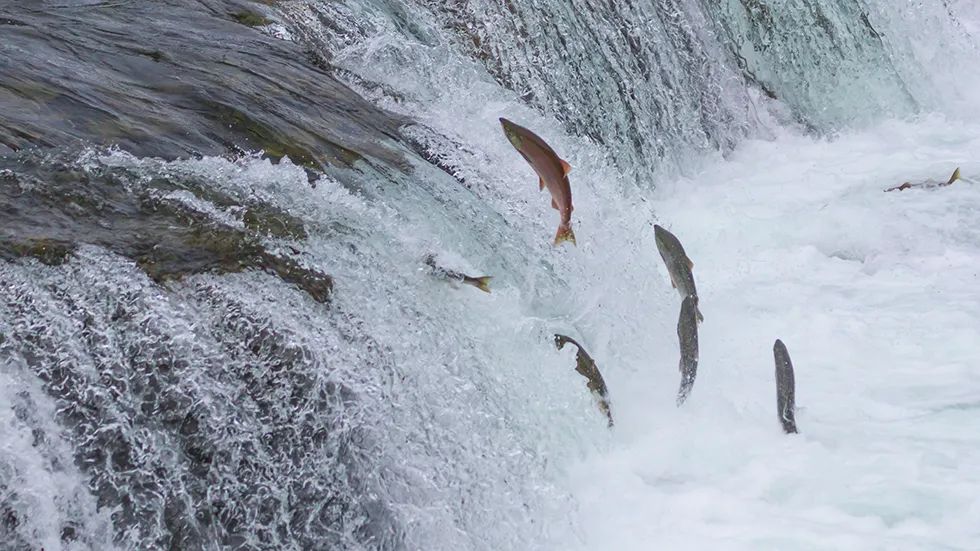
Pumped storage dams pump water from a lower reservoir to an upper reservoir when electricity demand is low. During periods of high electricity demand, the water is released back to the lower reservoir to generate power. Pumped storage allows energy from periods of low demand to be used during peak hours.
Advantages of Hydropower
Hydropower provides several key advantages as an energy source. First, hydropower is a renewable energy source. The water cycle continuously renews the water in dam reservoirs, allowing generation to continue indefinitely. According to the U.S. Department of Energy, hydropower is one of the most reliable and affordable sources of renewable electricity.
Hydropower is also very flexible. The flow of water driving the turbines can be increased or decreased easily, allowing hydropower to meet momentary increases or decreases in electricity demand. Hydroelectric dams with reservoirs can also store energy by pumping water uphill into the reservoir during periods of low electricity demand. This stored energy can then be used to generate electricity during periods of high electricity demand.
Overall, hydropower’s renewability, reliability, affordability, and flexibility make it an attractive energy source with many benefits. As the U.S. Department of Energy states, “Hydropower plays an important part in the nation’s energy mix and will continue providing stable electricity to many Americans for years to come.”
Sources:
https://www.energy.gov/eere/water/benefits-hydropower
https://www.crpud.net/clean-energy/benefits-of-hydropower/
Disadvantages of Hydropower
While hydropower has many advantages, there are also some notable disadvantages to consider.
One major disadvantage of hydropower dams is that they can disrupt aquatic life and ecosystems. Constructing a dam floods large areas upstream, which destroys habitats for fish, birds, and other wildlife that depend on the river. Dams also act as a barrier to fish migration and can interrupt breeding patterns. For example, salmon populations have declined in areas where they must navigate through dammed rivers (https://www.eia.gov/energyexplained/hydropower/hydropower-and-the-environment.php).
Hydropower is also vulnerable to droughts, as generating capacity drops substantially when water levels decline. During periods of drought, other sources like fossil fuels or solar may need to pick up the slack in electricity generation. This demonstrates the value of having a diversified energy portfolio.
Lastly, the upfront costs of constructing hydropower facilities are quite high, as massive dams and reservoirs are complex infrastructure projects. The environmental impact assessments and mitigation costs also add to the overall price tag. However, once built, hydropower plants can deliver reliable low-cost electricity for many decades.
Major Hydropower Dams
Some of the largest and most well-known hydropower dams in the world include:
The Hoover Dam in the United States has a capacity of 2,080 MW and generates around 4 billion kWh annually. Completed in 1936, it was one of the largest concrete structures in the world at the time. The dam helps provide drinking water and hydroelectricity to California, Arizona, and Nevada.
The Grand Coulee Dam in the United States is currently the largest hydropower producer in the United States with a capacity of 6,809 MW. The dam was completed in 1941 and spans the Columbia River. Annually it generates over 20 billion kWh of electricity.
The Three Gorges Dam in China is the world’s largest power station in terms of installed capacity at 22,500 MW. Completed in 2012, it spans the Yangtze River and produces around 100 billion kWh annually, supplying energy to the Central China grid.
Hydropower’s Share of Renewables
Hydropower currently provides the largest share of renewable electricity in the United States and worldwide. According to the U.S. Department of Energy, hydropower accounts for 28.7% of total U.S. renewable electricity generation and about 6.2% of total U.S. electricity generation as of 2021 [1]. The International Hydropower Association reports that around 60% of all renewable electricity globally is generated by hydropower as of 2022 [2]. The International Energy Agency states that hydropower’s contribution is 55% higher than nuclear power’s and larger than all other renewable sources combined, including wind, solar PV, bioenergy and geothermal [3].
In summary, hydropower provides the majority of renewable electricity in the United States and around the world. With abundant water resources, hydropower dams generate clean and renewable power on a massive scale.
Hydropower Around the World
China is currently the world’s leading hydropower producing country, generating over 1,274 billion kilowatt-hours of hydroelectricity in 2021 according to Statista. The Three Gorges Dam on the Yangtze River is China’s largest hydropower project, with an installed capacity of 22,500 MW. Hydropower accounts for roughly 17% of China’s total electricity generation. Hydroelectric dams provide renewable energy that supports China’s rapid economic growth and rising energy demands.
Brazil and Canada rank second and third globally in hydropower generation. In 2021, Brazil produced over 362 billion kWh of hydroelectricity, predominantly from large-scale dams located in the Amazon river basin. The Itaipu dam on the Paraná River bordering Brazil and Paraguay is one of the world’s largest operational hydroelectric facilities. Canada generated over 377 billion kWh of hydroelectricity in 2021, mainly from dams in remote northern regions. Canadian provinces like Quebec, British Columbia, Ontario and Manitoba rely heavily on hydropower for their electricity needs.
Other major hydropower producing countries include the United States, Russia, India, Norway, Japan, Venezuela, Sweden and France. Together the top fifteen hydropower nations account for over 90% of global installed hydroelectric capacity according to Yahoo Finance.
Future of Hydropower
Hydropower is expected to continue playing a major role in renewable energy generation in the coming decades. According to the International Energy Agency (IEA), hydropower is projected to remain the largest source of renewable electricity generation through 2040 [1]. Global hydropower generation is forecast to grow by over 17% between 2018 and 2040.
Several factors are contributing to the ongoing growth of hydropower:
- Increasing energy demand, especially in developing countries in Asia and Africa.
- Hydropower’s position as a reliable, flexible baseload power source.
- Government incentives and policies supporting renewable energy growth.
- Upgrades and expansion at existing hydropower facilities.
- New large-scale hydropower projects coming online, particularly in emerging markets.
Advancements in hydropower technologies are also supporting growth. Some key innovations include:
- New turbine designs that increase efficiency.
- Pumped storage capabilities to better integrate with intermittent renewables.
- Small modular hydropower systems suitable for remote areas.
- Floating solar photovoltaic panels paired with hydropower reservoirs.
With global focus on reducing carbon emissions, hydropower is likely to continue expanding its role as a reliable source of renewable power generation.

